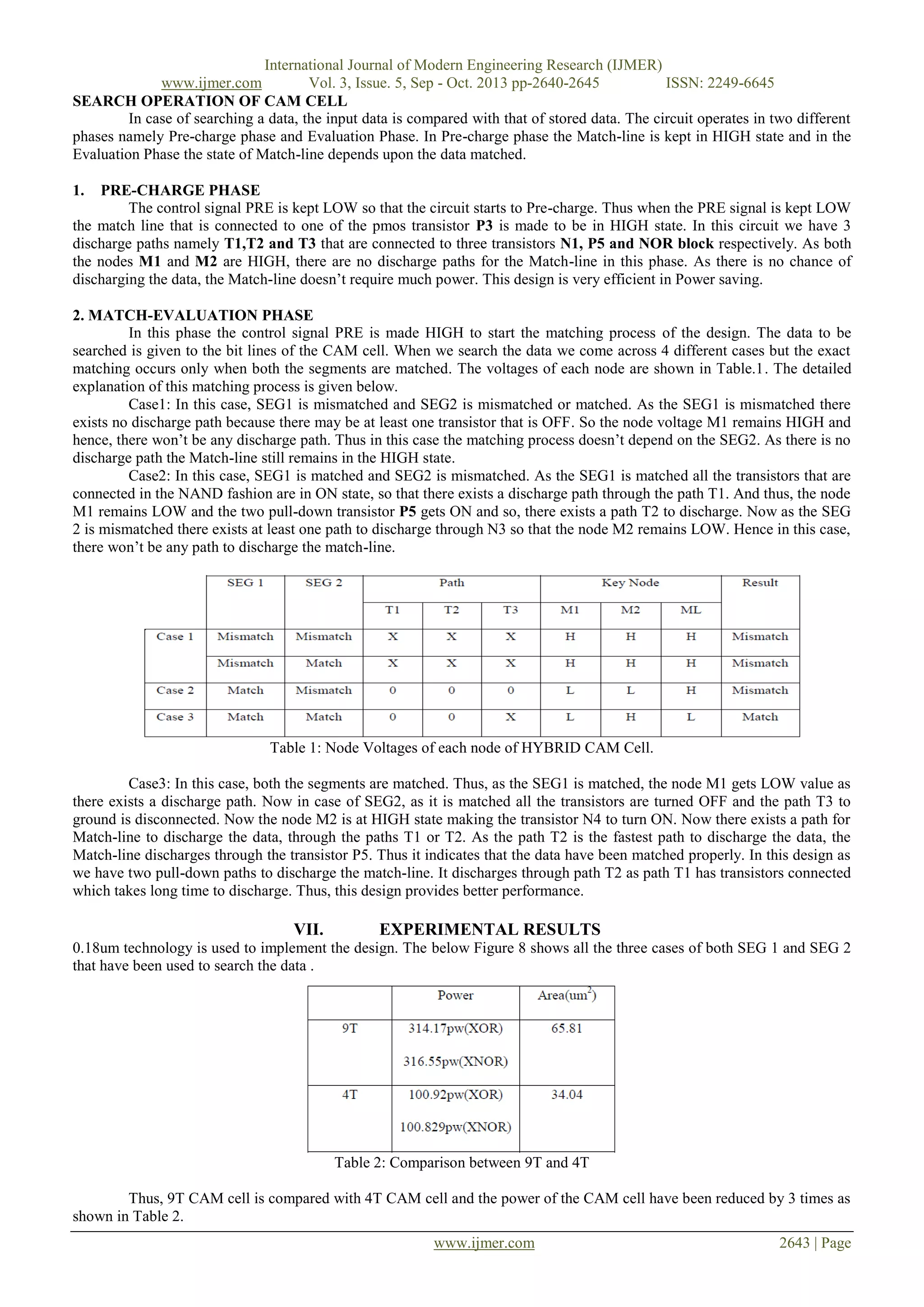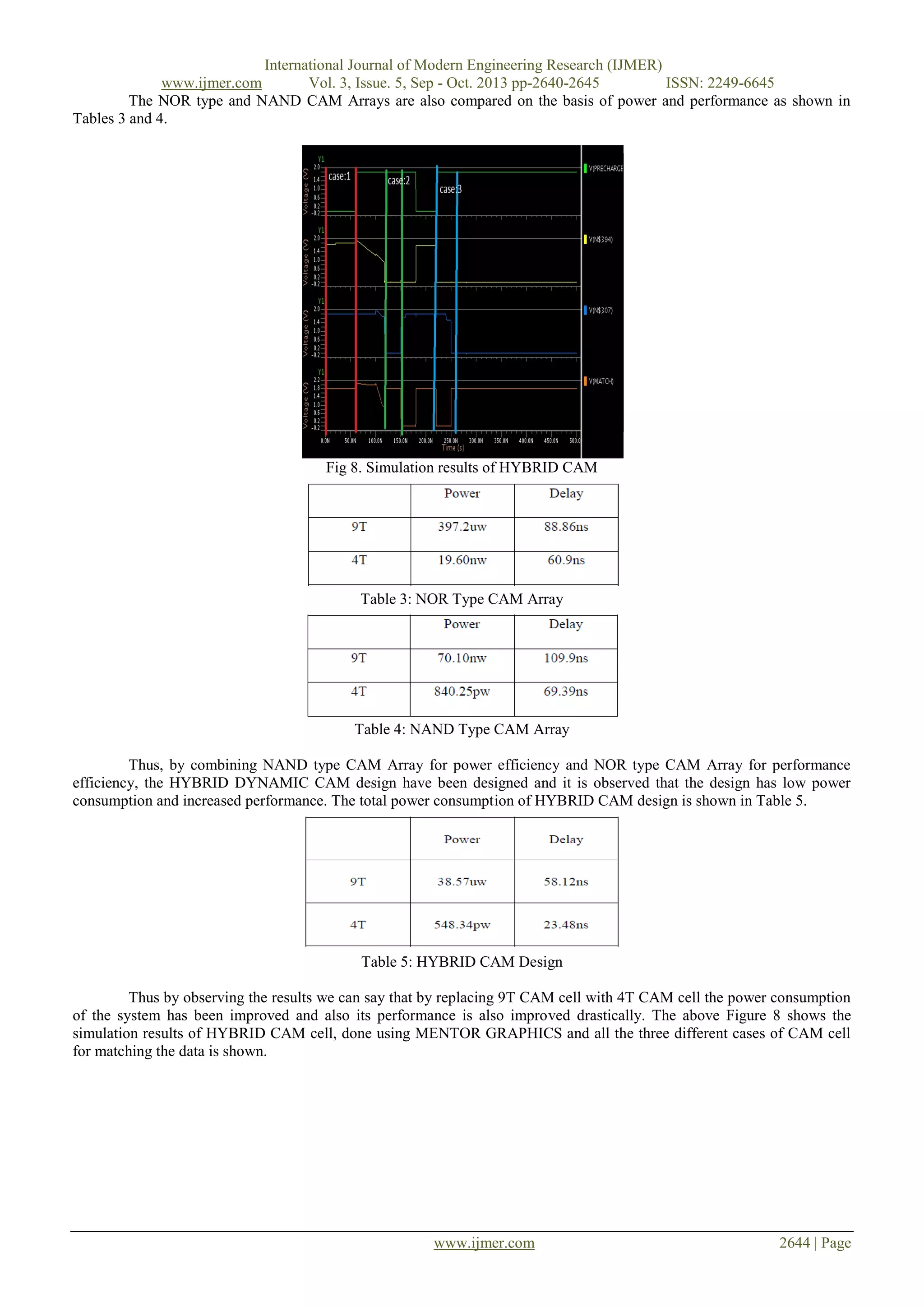This paper presents an optimized hybrid-type content-addressable memory (CAM) design that replaces the conventional 9-transistor (9T) CAM cell with a more efficient 4-transistor (4T) cell to improve power consumption, area, and performance. The hybrid design combines both nor-type and nand-type arrays, allowing for high-performance and low-power operation by utilizing each type's strengths. Simulation results demonstrate that the new design achieves significant reductions in power while enhancing performance, making it suitable for advanced applications.
![www.ijmer.com
International Journal of Modern Engineering Research (IJMER)
Vol. 3, Issue. 5, Sep - Oct. 2013 pp-2640-2645
ISSN: 2249-6645
Optimized CAM Design
S. Haroon Rasheed1, M. Anand Vijay Kamalnath2
Department of ECE, AVR & SVR E C T, Nandyal, India
Abstract:
Content-addressable memories (CAMs) are hardware search engines that are faster than algorithmic
approaches for searching applications. CAMs consist of conventional semiconductor memory (usually SRAM) with added
comparison circuitry that performs search operation to complete in a unique clock cycle. In case of sophisticated and high
end applications we need large sized CAM which utilizes large amount of power but this has to be avoided. This paper
proposes an idea for improving power, area and performance of the system of recently proposed high Performance HybridType CAM Designs. For this we replace the basic 9T CAM cell with a 4T CAM cell. The simulation results show the success
of the method.
Key words: Basic 9T CAM cell, 4T CAM cell, NOR-Type Array, NAND-Type Array, Hybrid CAM Design.
I.
INTRODUCTION
Content Addressable Memory is used to access the memory through the data rather than the address which is used
in the case of normal RAM‟s. The output of the CAM will be the location where the associated content is stored. In CAM
with parallel comparison feature the power consumption is lesser than the normal CAM. In case of CAM, the input data and
the stored data are being compared, if both matches then the match line are used to indicate it. Due to its low power and fast
matching capability it is mainly used in advanced applications like Strong ARM processors, ATM switches, etc.
In this paper we are designing a Hybrid Type CAM[7] design so that it should have low power and high
performance. Normally basic CAM cell consists of 9 transistors to write, read and match the data. It consists of both store
unit and match unit. The main drawback of this basic CAM cell is that it occupies more area, needs more power and has
large delay. So we need to explore modifications to it so that area, power and performance can be improved. So we are
designing 4 transistor CAM cell[8] such that these can be effectively used in many applications.
In the design CAM different techniques have been proposed to reduce the power consumption and improve the
performance of the CAM cell. A CAM cell design with XOR and XNOR blocks were designed [2], with different
combinations of pmos and nmos transistors, depending upon the type of application. But the main drawback of the proposed
design are usage of more number of transistors and more power consumption. A two stage CAM cell design is proposed [3],
to reduce power consumption where a control circuitry consisting of an inverter is used between the two stages. Performance
of this CAM cell design is degraded in this design and there exists the disadvantage of short circuit power dissipation. A
static pseudo nmos CAM has been designed[4] which requires an extra pmos transistor for every CAM cell which use in it,
so it is very bad idea to for each and every pmos for each stages. Other method has been designed which requires separate
cmos parallel CAM for searching the data[5] which requires lot of area to implement it and also extra precharge device[6] to
implement CAM. To overcome the disadvantages of the previous designs a Hybrid-Type CAM design[7] is proposed to
improve the power, area and performance of the CAM cell. This consists of both the NOR-type CAM design for the
high performance and NAND-type CAM design for Low-Power, as constraints.
II.
BASIC CONTENT ADDRESSABLE MEMORY
Basic CAM cell consists of both store unit for storing the data and compare unit for comparing the data. We store the data
using two cross-
Fig 1: Basic XOR CAM cell
coupled inverters and is implemented with 6T SRAM cell. The compare unit is designed using pass transistors. The fast pull
down transistor is used to discharge the data so that it indicates whether the data is matched. Depending on different
applications the compare unit can be designed with XOR type or XNOR type blocks. The main operation of CAM cell can
be described as: when the cross- coupled inverters store the data „1‟ and then the bit and nbit(bit bar/bitc) line has the data
„1‟ and „0‟ respectively. Now one of the two pull down transistors will be ON state and the other will be OFF state so that
there won‟t be any transistor path to discharge the match line and hence it remains in High-impedance state. Now if the bit
www.ijmer.com
2640 | Page](https://image.slidesharecdn.com/ag3526402645-131112032737-phpapp02/75/Optimized-CAM-Design-1-2048.jpg)
![International Journal of Modern Engineering Research (IJMER)
www.ijmer.com
Vol. 3, Issue. 5, Sep - Oct. 2013 pp-2640-2645
ISSN: 2249-6645
and nbit line has the data „0‟ and „1‟ respectively, then in the compare unit one of the pull down transistor will be in ON state
so that the fast pull down transistor moves to ON state. This discharges the match line indicating that the data have been
matched.
Fig 2: Basic XNOR CAM cell
III.
MODIFIED CAM CELL (4T CELL)
This modified 4T CAM cell design consists of 4 nmos transistors and the cells are arranged such that the two
transistors (tc1 and tco) are used to store the data and the remaining two transistors (tw1 and tw0) are used to write the
data[8]. The gates of tc1(„a‟) and tco(„b‟) are used as storage capacitance elements so that it can be used to store the data as
shown in fig 3. When the transistors tw1 and tw0 are in ON state the data can be transferred to the nodes a and b and then
these can be read using transistors tc1 and tc0.
Fig 3:4T XOR CAM cell
Normally matching operation can be done using match line that is connected to the output of the XOR type
transistors which are arranged using transistors tc1 and tc0. If the match line output is at logic „1‟ that indicates that the „data
stored‟ and the „input data‟ are matched. If the match line output is at logic „0‟, it indicates that there is no match and then
the match line gets discharged. Basically in this operation, first the match line has to be charged to logic „1‟ by using
precharge transistor and then the matching operation can be done. Even in case of mismatch, the match line needs to be
discharged, which can be done by using read transistor that is arranged between match line and ground. Fig 4. Shows the 4T
XNOR CAMCell.
Fig 4: 4T XNOR CAM cell
www.ijmer.com
2641 | Page](https://image.slidesharecdn.com/ag3526402645-131112032737-phpapp02/75/Optimized-CAM-Design-2-2048.jpg)
![www.ijmer.com
International Journal of Modern Engineering Research (IJMER)
Vol. 3, Issue. 5, Sep - Oct. 2013 pp-2640-2645
ISSN: 2249-6645
IV.
NOR-TYPE CAM ARRAY
In NOR-type CAM cell design, XOR-type CAM cell is used for better performance of the system. Here the pulldown transistors are arranged in NOR fashion so that it can discharge very fast and hence the performance improves. In case
of pre-charge, the Match-line is precharged to HIGH.
Fig 5: NOR type CAM Array
In the Evaluation phase, if the input data is matched with the stored data then the match line remains HIGH and if
all the cells are mismatched then the Match-line will discharge through the pull-down transistors. Thus the NOR-type CAM
cell provides better performance. But the drawback in this design is increase in Drain-Capacitance due to more number of
transistors. This drawback, increases Power consumption. Hence, it is only useful in case of High performance.
V.
NAND-TYPE CAM ARRAY
Unlike the NOR-type CAM cell, NAND-type CAM cell is used to reduce the power consumption of the system. In
this the NAND-type CAM, cell is arranged using XNOR type and the transistors are arranged in NAND fashion.
Fig 6: NAND CAM Array
Since the drain capacitance is less, the power consumption of the system is also less. In searching the data, initially
the match line is precharged to HIGH, in the pre-charge phase and the match line discharges to ground in the evaluation
phase, only when all the CAM cells are matched with the stored data. In case of mismatch the match line remains HIGH as
in that of the pre-charge phase. Thus the power consumption of the system can be improved. But the drawback with this
design is the time taken to discharge the match line is more, as it has long pull-down path. Hence, this NAND-type design is
performance inefficient/slow.
VI.
HYBRID-TYPE CAM DESIGN
Hybrid-type CAM design consists of both NOR-type Array with XOR CAM cell for performance advantage and
NAND-type Array with XNOR CAM cell for power advantage. Mainly we divide the complete circuit into 3 parts namely,
SEG1, SEG2 and CONTROL circuitry. In the SEG 1, we design the circuit using XNOR type and then arrange the pulldown transistors using NAND-type. In the SEG 2, we design the circuit using XOR type and the pull-down transistors are
arranged in NOR type design as shown in fig.7.
Fig 7: HYBRID CAM Structure [Ref 7]
www.ijmer.com
2642 | Page](https://image.slidesharecdn.com/ag3526402645-131112032737-phpapp02/75/Optimized-CAM-Design-3-2048.jpg)


![www.ijmer.com
International Journal of Modern Engineering Research (IJMER)
Vol. 3, Issue. 5, Sep - Oct. 2013 pp-2640-2645
ISSN: 2249-6645
Fig 9: 4T CAM Cell layout in 0.18 um standard CMOS Technology.
VIII.
CONCLUSION
Thus, a HYBRID CAM Structure has been designed for Low Power and High Performance using NOR and NAND
type CAM Array and area of the complete system has been reduced by replacing 9T basic CAM cell with 4T CAM cell with
a fast pull down path to accelerate the search operation.
REFERENCES
[1].
[2].
[3].
[4].
[5].
[6].
[7].
[8].
K. Pagiamtzis and A. Sheikholeslami, “Content-addressable memory(CAM) circuits and architectures: A tutorial and survey,”
IEEE J. Solid-State Circuits, vol. 41, no. 3, pp. 712–727, Mar. 2006.
Content Addressable Memory for Low Power and High Performance Applications by Ataur R. Patwary, Bibiche M. Geuskens,
Shih-Lien L. Lu, Solid-State Circuits, no.8, April 2008.
An Improved Comparison Circuit for Low Power Pre-computation-Based Content-Addressable Memory designs by Yu-Ting Pai,
Chia-Han Lee, and Shanq-Jang Ruan, IEEE. Solid-State Circuits, vol. 97,no. 9, June. 2009.
Design of Low-Power Content Addressable Memory Cell by KUO-HSING CHENG, CHIA-HUNG WEI, JIANN-CHYI RAU,
Solid-State Circuits.
H.Miyatake, M.Tanaka and Y.Mori,” A Design for high speed low power CMOS fully parallel Content Addressable Memory
macros”, IEEE J.Solid-StateCircuits,vol.38,no.11,pp.1958–1966, Nov 2003.
C.A.ZukowskiandS.Y.Wang,” Use of selective precharge for low power content addressable memories”, in Proc.Int.Symp.Circuits
and Syst.,1997,pp.1788–1791.
Yen-Jen Chang and Yuan –Hong Liao,”Hybrid-Type CAM design for both power and performance efficiency”, in VLSI systems,
Vol 16,No:8,Aug 2008.
Jose G.Delgado –Frias, Andy Yu and Jabulani Nyathi, “A Dynamic Content Addressable Memory Cell”, in VLSI Synstems, Vol
99, No:1, Sep 1999.
www.ijmer.com
2645 | Page](https://image.slidesharecdn.com/ag3526402645-131112032737-phpapp02/75/Optimized-CAM-Design-6-2048.jpg)